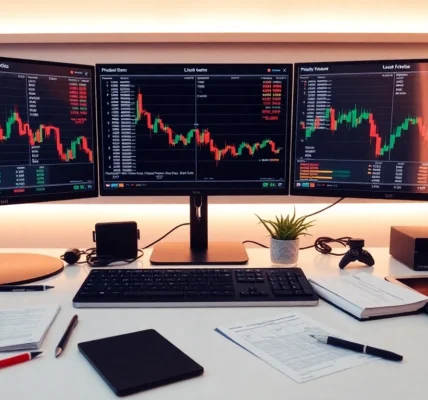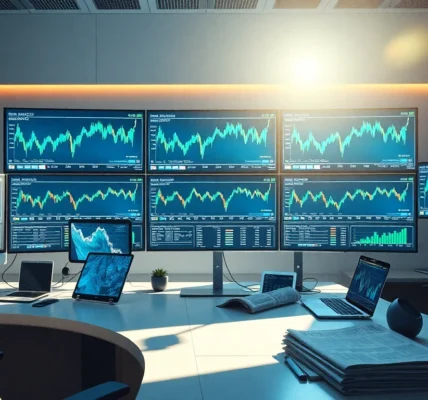Comprehensive Guide to Blockchain and NFT Technology in Modern Investing
As the financial landscape continues to evolve at a rapid pace, blockchain and non-fungible token (NFT) technologies are increasingly influencing investment strategies and market dynamics. This comprehensive guide delves into the foundational concepts, practical implementation steps, and future outlook of these groundbreaking innovations, equipping investors and developers with the insights needed to navigate this digital frontier effectively. For a detailed exploration suited to both beginners and seasoned market participants, visit our Blockchain and NFT Technology Guide.
Understanding Blockchain and NFT Fundamentals
What Is Blockchain Technology and How It Works
Blockchain technology is a decentralized digital ledger that records transactions across multiple computers, ensuring transparency, security, and immutability. Unlike traditional databases managed by central authorities, blockchains operate on a peer-to-peer network, where each block contains a set of validated transactions linked cryptographically to the previous one. This structure facilitates tamper-resistant record-keeping, critical for applications like cryptocurrencies, supply chain management, and digital identity verification. From Bitcoin’s inception to enterprise blockchain solutions, the core principle remains constant: trustless, secure, and transparent data management.
The Rise of NFTs and Their Market Significance
Non-fungible tokens (NFTs) represent ownership of unique digital assets secured via blockchain technology. Unlike cryptocurrencies such as Bitcoin or Ether, which are interchangeable, NFTs are indivisible and distinct, making them ideal for digital art, music, gaming items, and other collectibles. The explosive growth of NFT markets, hitting a cumulative market cap of over $9.3 billion, exemplifies their significance in creating digital scarcity and enabling artists and creators to monetize intellectual property directly. Major auction houses like Christie’s and Sotheby’s embracing NFTs underscore their mainstream acceptance and profound market impact.
Implementing Blockchain and NFT in Your Investment Portfolio
Step-by-Step Guide to Buying NFTs Safely
- Research and select reputable platforms: Use established marketplaces like OpenSea, Rarible, or Mintable that implement robust security protocols and user verification processes.
- Create a secure digital wallet: Utilize wallets compatible with ERC-721 or ERC-1155 standards, such as MetaMask or Trust Wallet, ensuring private keys are stored securely offline.
- Conduct due diligence: Verify the creator’s authenticity, project origin, and transaction history before purchasing.
- Evaluate the asset: Consider the rarity, provenance, and market trends impacting potential value appreciation.
- Execute the purchase: Use ETH or relevant cryptocurrencies for transactions, and confirm payment through secure channels, avoiding suspicious links or offers.
Remember, the NFT market can be volatile; setting clear investment limits and ongoing monitoring are essential for sustainable gains.
Integrating Blockchain Data Into Investment Strategies
Blockchain’s transparent data allows investors to analyze transaction histories, ownership records, and market activity to inform decision-making. Advanced analytics tools can extract insights from on-chain metrics such as wallet activity, token flow, and liquidity positions. Integrating these data points into traditional investment strategies can help in identifying emerging trends, undervalued assets, or potential market manipulations. For example, tracking large token transfers could signal upcoming significant market moves, while on-chain analytics can validate the sustainability of a blockchain project or NFT collection.
Common Challenges and How to Overcome Them
Valuable as blockchain and NFTs are, investors face hurdles like cybersecurity threats, regulatory uncertainties, and market volatility. To mitigate these risks:
- Enhance security protocols: Use hardware wallets and multi-factor authentication.
- Stay informed on legal developments: Regulatory landscapes are evolving; consultancy with legal experts can preempt compliance issues.
- Diversify holdings: Avoid concentration in volatile or illiquid assets.
- Educate continuously: Participate in webinars, forums, and industry reports to stay abreast of market innovations and risks.
Market Trends and Future Outlook for Blockchain and NFTs
Current Market Data and Analysis
Recent data indicates that despite market fluctuations, the NFT sector continues to attract significant investments, with notable sales surpassing million-dollar figures. Meanwhile, blockchain adoption is expanding across industries—from finance to supply chains—driven by enterprise-grade solutions and regulatory clarity in certain regions. The overall market remains highly dynamic, with volatility driven by technological developments, investments, and regulatory debates.
Emerging Use Cases and Technologies
Innovations like decentralized finance (DeFi), interoperable blockchains, and social tokens built on NFT platforms exemplify the expanding applications. Governments and corporations exploring central bank digital currencies (CBDCs) signify a future where blockchain intersects deeply with mainstream financial infrastructure. Moreover, the integration of artificial intelligence with blockchain could enhance automated trading, smart contract deployment, and fraud detection, pushing the boundaries of digital asset management.
Predictions for the Next 5 Years
Experts forecast sustained growth, with blockchain and NFT markets potentially reaching valuation levels in the hundreds of billions. Greater mainstream acceptance, improved regulatory frameworks, and technological advancements are expected to reduce barriers to entry. On the investment front, institutional adoption may normalize, creating more robust, transparent markets. Additionally, AI-powered analytics and scalable blockchain networks will facilitate faster, more secure transactions, encouraging broader usage across sectors.
Security and Legal Considerations in Blockchain & NFT Trading
Protecting Digital Assets Securely
Securing blockchain assets involves using hardware wallets, encrypting private keys, and implementing strong passwords. Phishing attacks and scams are prevalent; hence, verifying the authenticity of platforms and communications is vital. Staying vigilant, updating software regularly, and avoiding public Wi-Fi for transactions further bolster security.
Legal and Regulatory Compliance
Given the evolving legal landscape, compliance with local laws around digital assets is crucial. Regulations around KYC (Know Your Customer), AML (Anti-Money Laundering), taxation, and intellectual property rights vary across jurisdictions. Consulting legal experts and adhering to platform-specific guidelines help prevent legal pitfalls. Transparency in ownership and transaction records facilitated by blockchain aids in compliance but does not exempt investors from due diligence requirements.
Avoiding Common Scams and Pitfalls
Fraudulent schemes such as fake NFTs, pump-and-dump schemes, and impersonation scams are widespread. To avoid these, verify seller identities, scrutinize transaction histories, and be cautious of offers promising guaranteed returns. Educate yourself on typical scam tactics and leverage community forums for feedback on specific projects or platforms.
Advanced Strategies for Investors & Developers
Leveraging Smart Contracts Effectively
Smart contracts automate execution of contractual conditions, reducing reliance on intermediaries. Investors can use smart contracts for decentralized escrow, yield farming, or automated dividend distributions. Developers benefit from creating transparent, tamper-proof code for NFT minting, royalties, and cross-platform interoperability, enhancing credibility and efficiency.
Developing NFT Projects and Marketplaces
Successful NFT creation requires understanding artistic, technical, and legal aspects. Platforms like Ethereum, Binance Smart Chain, and Flow provide infrastructure for minting. Focus on compelling content, community engagement, and utility to increase market appeal. Building marketplaces involves deploying smart contracts that facilitate listing, bidding, and transferring assets seamlessly, with adherence to security best practices.
Performance Metrics to Track Success
For investors, key metrics include trading volume, liquidity levels, price appreciation, and market cap. Developers should monitor smart contract performance, platform transaction throughput, user engagement, and compliance adherence. Regular analysis ensures optimized strategies and project health, enabling proactive adjustments to fluctuating market conditions.



